PNPLA2
-
Official Full Name
patatin-like phospholipase domain containing 2 -
Overview
Adipose Triglyceride Lipase (ATGL), an enzyme that catalyzes the rate limiting hydrolysis step of triglycerides in the triacylglycerol lipolysis cascade, is expressed predominantly in adipose tissue, but is also found in lesser amounts within cardiac and skeletal muscle. Its function is to initiate the breakdown of intracellular triglycerides into fatty acid monomers. Individuals deficient in the ATGL enzyme are at higher risk for cardiac dysfunction and premature death because of increased size and accumulation of lipid droplets within cardiac myocytes. -
Synonyms
PNPLA2;patatin-like phospholipase domain containing 2
Recombinant Proteins
- Human
- Mouse
- Chicken
- Rat
- E.coli
- Wheat Germ
- In Vitro Cell Free System
- Mammalian Cells
- HEK293
- His
- SUMO
- GST
- DDK
- Myc
- Non
- Avi
- Fc
- Flag
Background
What is PNPLA2 protein?
PNPLA2 (patatin like phospholipase domain containing 2) gene is a protein coding gene which situated on the short arm of chromosome 11 at locus 11p15. The PNPLA2 protein has a patatin-like phospholipase domain that plays a key role in catalyzing the lipolysis reaction. In addition, PNPLA2 contains a C-terminal transmembrane domain that enables it to locate on the surface of lipid droplets within cells. PNPLA2 is a key enzyme that catalyzes the first step of the lipolysis reaction, responsible for hydrolyzing triacylglycerol to diacylglycerol and free fatty acids. This process is important for maintaining energy balance, regulating insulin sensitivity and preventing fat accumulation. The PNPLA2 protein is consisted of 504 amino acids and its molecular mass is approximately 55.3 kDa.
What is the function of PNPLA2 protein?
The main functions of PNPLA2 in the cell include the regulation of lipid metabolism, especially that of triacylglycerol. It plays a role in the endoplasmic reticulum within the cell and is able to hydrolyze long chain fatty acids released from triacylglycerol, thus participating in energy metabolism and fatty acid reuse. In addition, the activity of PNPLA2 is also related to inflammatory response, and it may affect the production of inflammatory mediators and the activity of inflammatory cells by regulating the metabolism of fatty acids.
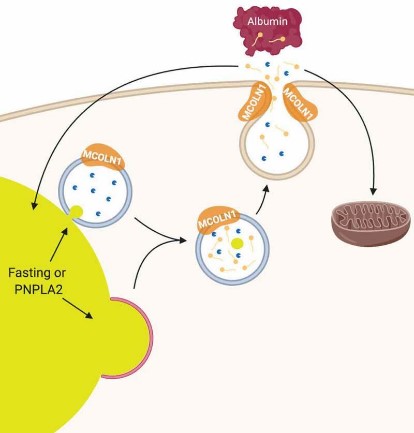
Fig1. Working model. Nutrient deprivation and PNPLA2 activation drive lipophagy and FA generation in lysosomes. (Wenqi Cui, 2021)
PNPLA2 Related Signaling Pathway
The signaling pathway involved in PNPLA2 protein is mainly related to the regulation of lipid metabolism. As a member of the phospholipase A2 (PLA2) family, PNPLA2 plays an important role in the cell by hydrolyzing phosphatidylinositol to produce diacylglycerol (DAG) and free fatty acids. These products are key secondary messengers in cell signaling and can activate a variety of signaling pathways, such as the protein kinase C (PKC) pathway, which is involved in regulating physiological processes such as cell growth, differentiation, migration and inflammatory response. In addition, PNPLA2 interacts with insulin signaling pathways to influence glucose and fatty acid metabolism.
PNPLA2 Related Diseases
PNPLA2 protein is associated with a variety of diseases, including obesity, diabetes, fatty liver, and cardiovascular disease. The occurrence of these diseases is related to the disorder of fat metabolism, and the abnormal function of PNPLA2, as a key enzyme of fat decomposition, may lead to the accumulation of fat and the imbalance of energy metabolism, and then lead to the occurrence of these diseases, such as non-alcoholic fatty liver disease (NAFLD) and atherosclerosis. In addition, PNPLA2 may be associated with inherited disorders of fat metabolism, such as familial partial lipodystrophy (FCPD).
Bioapplications of PNPLA2
PNPLA2 gene polymorphism is associated with the risk of ischemic stroke in patients with type 2 diabetes mellitus (T2DM), and specific genotypes may serve as genetic markers to predict ischemic stroke in patients with T2DM. At the same time, it provides new perspectives and potential therapeutic targets for the diagnosis and treatment of self-related diseases.
Case Study
Case Study 1: Teresa Rossi, 2023
Triple-Negative Breast Cancer (TNBC) is a subtype of breast cancer that differs from other types of breast cancers in the faster spread and worse outcome. TNBC presented limited treatment options. BET (Bromodomain and extra-terminal domain) proteins are epigenetic readers that control the expression of different oncogenic proteins, and their inhibition (BETi) is considered a promising anti-cancer strategy. Recent evidence demonstrated the involvement of BET proteins in regulation of metabolic processes. ATGL expression was determined by immunoblot and qRT-PCR, and the impact of ATGL function or protein knockdown, alone and in combination with BETi, was assessed by analyzing cell proliferation, mitochondrial function, and metabolic activity in TNBC and non-TNBC cells culture models. TNBC cells treated with two BETi markedly increased ATGL expression and lipolytic function and decreased intracellular lipid content in a dose and time-dependent manner. The short-chain FA propionate entered directly into the mitochondria mimicking ATGL activity. After BETi treatment, the FoxO1 protein is upregulated and binds to the PNPLA2 promoter leading to the induction of ATGL.
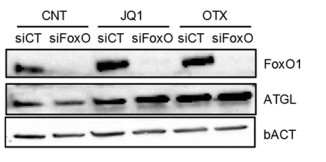
Fig1. Protein expression analysis of ATGL and FoxO1 in control (siCNT) and FoxO1 siRNA cells (siFoxO) after 48 hours of siRNA transfection combined with 1 μM BETi for the last 24 hours.
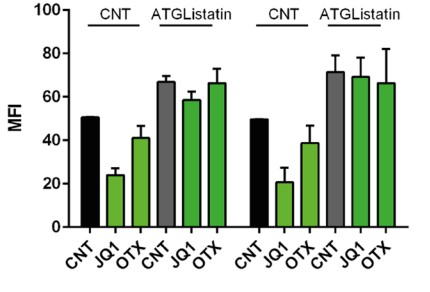
Fig2. A flow cytometry analysis of LDs content stained with BODIPY 500/510 in MDA-MB231 and Hs578t cells treated with ATGListatin and BETi.
Case Study 2: Haofan Yin, 2021
Abnormal lipid metabolism is the sign of tumour cells. Previous researches have revealed that the lipolytic pathway may contribute to the progression of colorectal cancer (CRC). However, adipose triglyceride lipase (ATGL) role in CRC cells remains unclear. This study showed that elevated ATGL positively correlates with CRC clinical stages and negatively associates with overall survival. Overexpression of ATGL significantly promotes CRC cell proliferation, while knockdown of ATGL inhibits the proliferation and promotes the apoptosis of CRC cells in vitro. Moreover, in vivo experiments, ATGL promotes the growth of CRC cells. Mechanistically, ATGL enhances the carcinogenic function of CRC cells via promoting sphingolipid metabolism and CoA biosynthesis pathway-related gene levels by degrading triglycerides, which provides adequate nutrition for the progression of CRC.
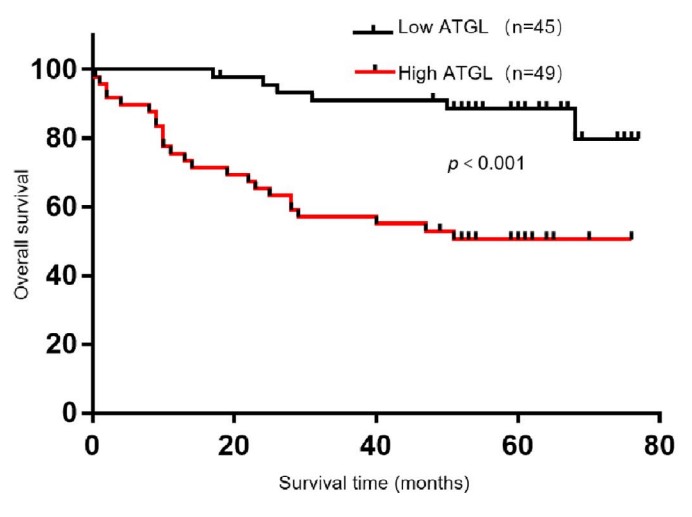
Fig3. Overall survival of CRC patients in CRC Tissue Microarray with low and high ATGL expression.
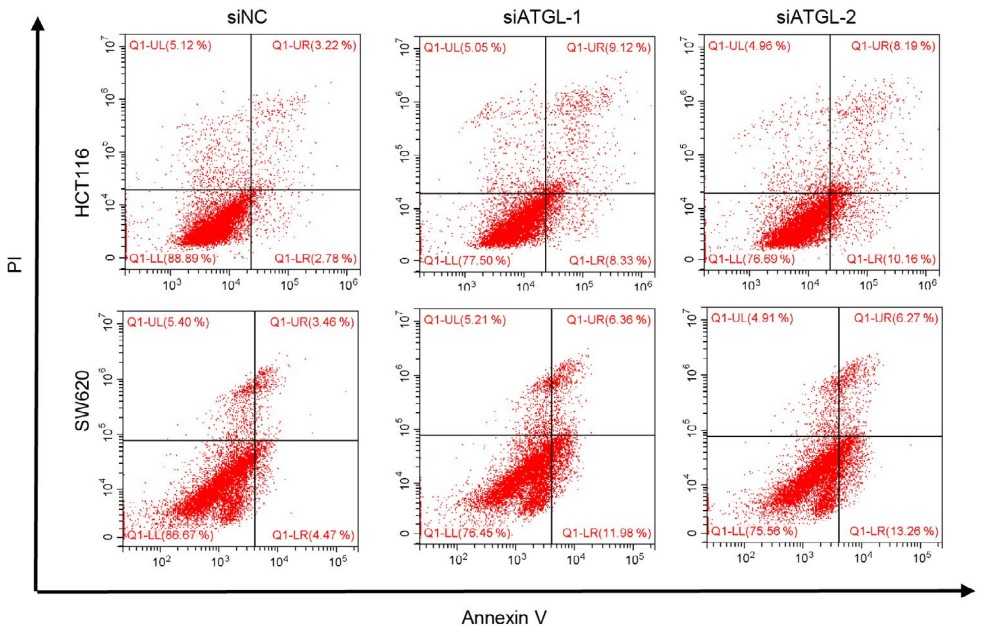
Fig4. Detect apoptosis of indicated ATGL-silenced and control cells by flow cytometry.
Quality Guarantee
High Purity
.jpg)
Fig1. SDS-PAGE (PNPLA2-1333H)
.
.jpg)
Fig2. SDS-PAGE (PNPLA2-251HFL)
Involved Pathway
PNPLA2 involved in several pathways and played different roles in them. We selected most pathways PNPLA2 participated on our site, such as Glycerolipid metabolism,Metabolic pathways,Regulation of lipolysis in adipocytes, which may be useful for your reference. Also, other proteins which involved in the same pathway with PNPLA2 were listed below. Creative BioMart supplied nearly all the proteins listed, you can search them on our site.
| Pathway Name | Pathway Related Protein |
|---|---|
| Glycerolipid metabolism | LYCAT,LPIN3,Akr1b3,ALDH9A1A.1,PNLIPRP2,LPIN1,AGPAT1,AGPAT2,Cel,AKR1A1B |
| Metabolic pathways | G6PCA.1,PIGN,AMDHD1,PLA2G4AA,HMGCL,ATP6V1D,COX6A2,UQCR10,DPM1,ATP6V1B2 |
| Regulation of lipolysis in adipocytes | GNAI1,PIK3CB,INS1,NPY1R,ABHD5,PTGER3,GNAI3,TSHR,PIK3CA,PTGS2 |
Protein Function
PNPLA2 has several biochemical functions, for example, triglyceride lipase activity. Some of the functions are cooperated with other proteins, some of the functions could acted by PNPLA2 itself. We selected most functions PNPLA2 had, and list some proteins which have the same functions with PNPLA2. You can find most of the proteins on our site.
| Function | Related Protein |
|---|---|
| triglyceride lipase activity | AADAC,PNPLA3,PNPLA4,CEL.1,PNLIPRP2,LIPCA,CES1,LPL,LIPE,PNLIP |
Interacting Protein
PNPLA2 has direct interactions with proteins and molecules. Those interactions were detected by several methods such as yeast two hybrid, co-IP, pull-down and so on. We selected proteins and molecules interacted with PNPLA2 here. Most of them are supplied by our site. Hope this information will be useful for your research of PNPLA2.
SMAD9;EGFR;MARK3;UBE2R2;ppk;PHYHIP;FKBP5
Resources
Research Area
Related Services
Related Products
References



